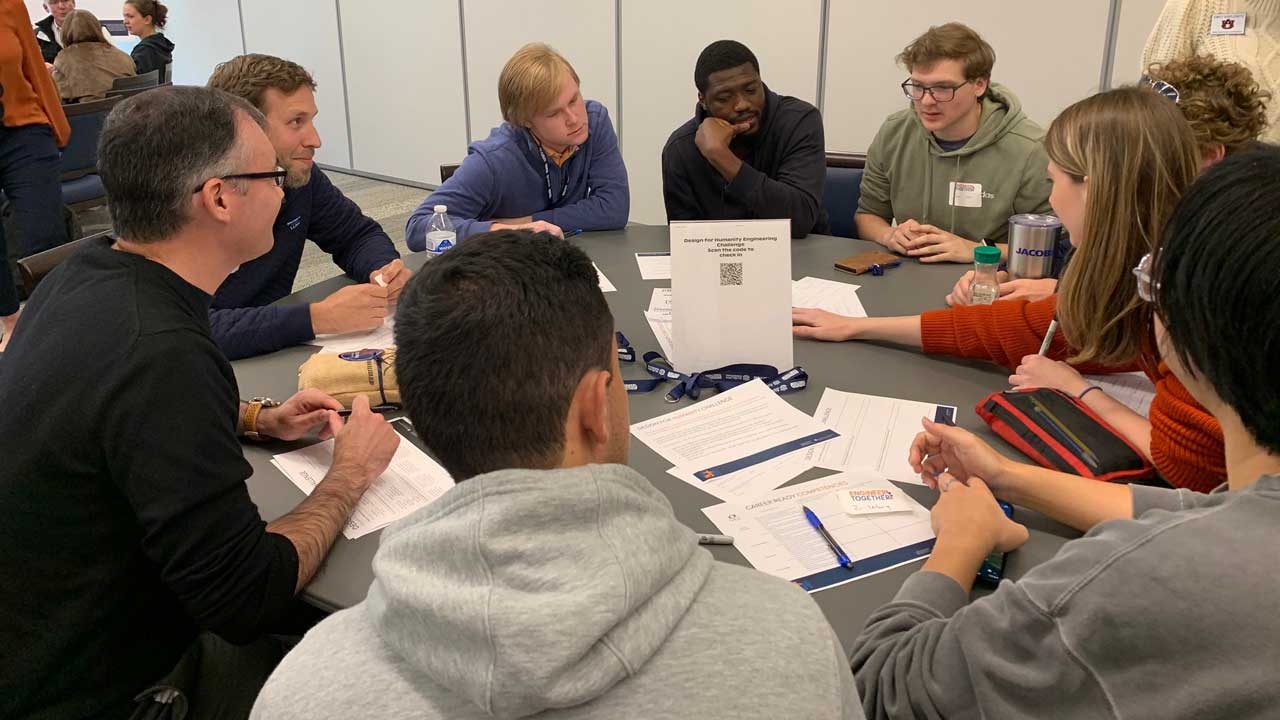Design for Humanity Challenge poses “people-centric” engineering design prompt
Published: Mar 27, 2023 9:15 AM
By Cassie Montgomery
In conjunction with the Samuel Ginn College of Engineering’s inaugural Engineer Together Day, the Office of Career Development and Corporate Relations (CDCR) hosted the Design for Humanity Engineering Challenge.
More than 60 students representing all engineering disciplines, as well as students from Auburn’s School of Industrial and Graphic Design, along with engineering faculty, industry representatives from Milliken & Company, AM/NS Calvert and Lockheed Martin were in attendance and active participants in the challenge. The challenge was centered on designing solutions with a people-first mindset that considers diverse needs and a wide variety of possible users. The goals of the challenge were three-fold:
- Educate students on career readiness competencies sought by employers and examine concrete tasks where specific competencies are developed;
- Embed faculty members and industry professionals to provide guidance and feedback for student groups examining tasks in a practical scenario;
- Create a space for students to practice designing solutions with a people-focused mindset and recognize failures that can occur diverse needs and perspectives are not appropriately considered.
“Specifically, the Design for Humanity Challenge offered participants a problem to consider approaches to communicating with an autonomous vehicle where students divided into small groups to identify solutions and determine how they will suit the needs of multiple populations. While doing so, they were asked to consider the career readiness competencies most critical to this stage of problem solving, highlighting not only the critical thinking and problem solving engineers so commonly identify with but the social competencies that are so critical to success such as communication, teamwork, professionalism, and equity and inclusion” said Jessica Bowers, CDCR manager of career development content and strategy. “Their solutions were then evaluated using a shared rubric to assess responses and identify a winning team.”
Billed as an opportunity to identify who engineers design for and how the audience of end users affects what engineers create, the particular challenge allowed participating students a chance to roleplay as members of the engineering team aiming to design an automated vehicle for the “every person.” To successfully do so, the teams needed to consider how users will communicate with the vehicle and tell the car where to go.
In introducing the challenge, Bowers reviewed a series of engineering product failures that do not sufficiently suit the needs of users based on themes of gender, skin color or physical ability. Examples included air bags built to male specifications, automated soap dispensers not designed to recognize dark skin and evacuation infrastructure not designed for elderly or individuals with limited personal mobility or access to motor vehicles.
In several of the examples, not only is convenience at stake, but also personal and community safety. As a large group, participants discussed that such failures are not intentional but the result of factors such as desire to accelerate production for market release, lack of potential user group input in the design process, or limited representation and unintended implicit bias among those designing solutions.
“I was incredibly impressed not only with each individual's creativity and thoughtfulness but also with how well they listened and collaborated with each other,” said Jeffrey LaMondia, professor of civil and environmental engineering and one of two faculty coaches for the challenge. “These students demonstrated how Auburn engineers are able to think deeply about complex challenges and work across disciplines to arrive at innovative solutions.”
Industry representatives also commented on the relevance of the topics discussed at the event.
“I shared the details with our Chief Human Resources Office and he was really impressed with the event. He would like to highlight our engagement with Auburn at a future Milliken Board Meeting,” said Ed Harsoki, Vice President of Human Resources for Milliken and Company Floor Covering Division.
“We hope that by providing programs such as this one, we are further equipping Auburn Engineering students beyond their technical training to design better products, processes and communities that more accurately represent the needs and interests of the populations they will serve,” said Bowers.
After the event, participants were provided with resources for how to apply the experience to their future job searches and interview experiences, with suggestions for using what they learned in the challenge as a potential example for responding to employer interview questions.
“We hope students use the provided materials and their experiences to illustrate their level of competence in the skills we know employers seek,” Bowers said. “And as always, we encourage engineering students to access the Career Development and Corporate Relations Office for support in any aspect of their career development process, as we seek to equip and empower students to discover, develop and launch professional experiences and purposeful careers.”
Media Contact: , cmontgomery@auburn.edu, 334.844.3668
A team of students and faculty participate in the Design for Humanity Challenge.

